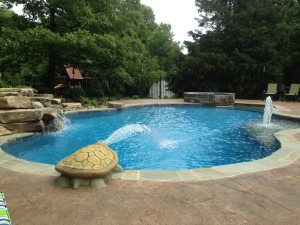Anytime you add chlorine to water, hypochlorous acid is formed (HOCL). HOCL is the most powerful killing form of chlorine in water. Hypochlorite ion (OCI) is also formed, and this is a weak form of chlorine in water. How much HOCL and OCI that is formed in the water is determined by your pool’s pH levels. As the pH goes up, the less HOCL and the more OCI. Free available chlorine is the active type of chlorine we want in the water- it’s this type of chlorine that does the killing.
Sometimes chlorine molecules in the water combine with ammonia and nitrogen compounds in the water. This is what forms chloramines. These are sometimes known as ‘combined chlorine’. In this way, chloramines lose much of their sanitizing power. They are actually up to 80% less effective than free chlorine molecules.
You can’t necessarily prevent chloramines from forming in your water. They are formed any time ammonia and nitrogen are in your pool’s water. Ammonia and nitrogen enter your water easily by swimmers. They can be found in their sweat, urine (ew), saliva, or even fecal matter (although, hopefully not in your pool). Even if you banned swimmers from your pool, these elements would find their way in through rain or residual lawn products.
How do you tell when you have chloramines in your pool? The easiest way to find out is by smell. Chloramines smell bad. They will irritate the eyes and the skin of swimmers. If your pool smells strongly of chlorine, what you’re actually smelling is chloramines. You can then test the combined chlorine molecule levels in your pool with a pool test kit. This is how you will tell:
Free chlorine reading – total chlorine reading = combined chlorine reading (chloramines)
Anything over .3ppm should be treated as soon as possible.
How to Remove Chloramines:
- Try adding a large does of chlorine. Typically your pool will require 3 to 6 times more chlorine than that of a normal dose. You want the level of chlorine to be between 5 to 10ppm and stay there for 4 hours. this is called ‘superchlorination’. When you shock your pool in this way, the chlorine will rip apart the molecular combinations and destroy the chloramines. Make sure there is NO swimming taking place during this time. There should be no swimmers in the water until the level of chlorine has drpped to 3ppm or less.
- If you do not wish to use a chlorine shock treatment, try using potassium peroxymonosulfate. You need to add 1 pound of ‘shock’ for each 10,000 gallons of water. It’s okay to add a little extra as well.
- The third option to remove chloramines is adding ozone to the water. If your pool has an ozone generator, the oxidation of the ammonia and nitrogen compounds will occur when the ozone system is operating. The longer you have the system in operation, the more ammonia and nitrogen is destroyed.
Always remember: if your pool has a strong chlorine odor, or you eyes become red and itchy after swimming, your pool either has too many chloramines or your pH and alkalinity levels may be off as well and contribute to swimmer discomfort. Testing your water will lead you to in the right direction to discover what needs to be adjusted for perfect happy water.

